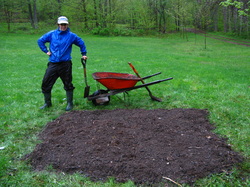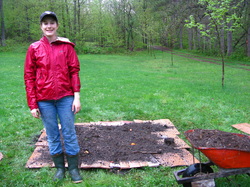|
Over the weekend, I finally built my own garden. I've wanted to have my own garden for years now, but this was the first summer that I was going to be in one place long enough to start it. Initially I was going to have my dad till a part of the land at his cottage for me. My parents and grandparents used to have a garden up at the cottage, but finally gave up on it since the soil is poor and the animals have way more time and patience to infiltrate the garden than my parents did keeping them out. Because maple syrup season has just finished, my dad didn't have time to till the garden plot for me. I figured that doing conventional gardening would be easiest for my first try. I debated doing it myself... but if you know me and heavy machinery, you would probably agree that this is a bad idea. With time running out, I decided that since I'm taking a permaculture class that has been pleasantly taking over my life, I should try to actually implement what I've learned. After all, that's why I wanted to take the class - to use some skills in real life. Permaculture generally discourages the use of tilling the land, so my first step was to figure out how to make a garden without using a tractor or rototiller. It turns out that there's a way to build soil quality and create a garden without digging it up. This is called sheet mulching, and there's a pretty cool video about how UMass created a large permaculture garden at their school by using this same technique. Basically, on top of the grass, you layer compost, cardboard, and mulch to create a rich layer of organic matter, which your plants will like. You have to be careful to have a good carbon to nitrogen ratio of 30:1, which is ideal for plants. For example, if you add lots of unfinished compost (vegetable scraps), you should put something more "brown" (like leaves or newspaper, things high in carbon) as the next layer. That's how you do it in theory. I decided last week that I was going to do sheet mulching. Where was I going to get so much cardboard, compost, and more compost/mulch in a week? I live in the city. Luckily, I had decided on this plan the day before recycling day. I "liberated" about thirty cardboard boxes from the recycling piles on the street. They had already been flattened and organized into larger boxes, so at least I didn't have thirty open boxes lying around my apartment. Now for the compost. I had read from the TOHU website that the St. Michel environmental complex was giving away free compost. Ka-ching! I went there before my permaculture class and loaded up my car trunk with compost. Well, initially I looked like an idiot because since I didn't have a spade or any real containers to put said compost, I was using my snow shovel to spoon it into plastic recycling bags. The man next to me was nice enough to lend me a real shovel. However, I could only collect about three full recycling bags full of it before I realized I was late for my class. I wasn't quite sure what to use for the top mulch layer, but my permaculture teacher Graham helped me out with the list of free mulch that I had access to at the cottage (leaves, grass clippings, old compost, etc). Then came the moment of truth: could I pull together my scraggly collection of vegetable scraps, stolen cardboard boxes, newspapers, free compost, and other various organic matter-y things to somehow make a garden? The cheap-o (or thrifty person, as I prefer) in me said YES! My parents looked skeptical as carted wheelbarrows full of boxes, compost, rotting vegetables, and seeds down to my claimed space. I initially thought that I would make a garden about 5 feet wide and 10 feet long. As soon as I put the first layer of vegetable scraps, I realized I needed to make it about half that size. So I made a garden 4 feet by 5 feet (even that's exaggerating a bit). But magically, I just barely had enough materials to make a raised garden. This is me standing in front of the smallest garden in the world: Oh yes, and I forgot to mention that it was RAINING the entire day that I did this. Well it wasn't just me- Lacey, the most devoted girlfriend in the world, also helped me out. Eventually, we put the top layer of compost on. I had luckily found the jackpot of compost at the cottage, which happened to be where my family has been dumping food scraps outside for approximately 10 years. Normally you're supposed to do the sheet mulching process in late summer of the year before you want the garden, but I did this in a week. I figured I should just put finished/old compost on top, otherwise the seeds would be trying germinate in leaves or whatever else I could rustle up.  <This Lacey in front of the finished sheet mulch. We planted rows of carrots (I like carrots), peas (because peas like carrots and they're legumes so they give nitrogen to the soil), basil (supposedly basil will confuse mammals and dilute the good smells of the other growing leaves), and pumpkins/zucchinis/cucumbers (their prickly leaves will hopefully keep out the mammals). I also planted sunflowers because it goes with the three sisters, which I will explain another time, and I didn't have enough room for in my garden, but I figured probably fewer animals want to eat sunflowers. Hopefully at least one plant will grow. Before it gets eaten by the groundhog.
0 Comments
|
About ShonaI'm an eco-conscious girl from Montreal, Quebec. I'm currently an adjunct science professor at Champlain College of Vermont (Montreal Campus). I'm interested in any opportunities to expand my experience with grassroots activism, climate change legislation, or environmental education. Archives
March 2016
Categories
All
|


 RSS Feed
RSS Feed
